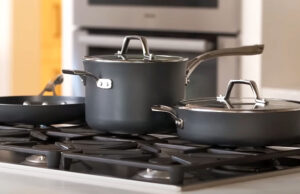As an Amazon Associate, I earn from qualifying purchases at no extra cost to you.
Whirlpool Dishwasher 1-Hour Wash vs Normal: Which One Saves Time and Works Better?
You want to wash your dishes fast but still make sure they come out clean. That’s why you might be wondering if the Whirlpool dishwasher 1-hour wash is better than the normal cycle. I’ve used both settings, and I know how confusing it can be when you’re short on time but still want sparkling clean plates. In this article, I’ll share the exact answer from my own experience: the 1-hour wash is faster but might not clean as deeply as the normal cycle.
How long each cycle takes and what really happens during that time
When you use a dishwasher, the time it takes to clean your dishes can make a big difference in your day. The Whirlpool dishwasher gives you two main choices: the 1-hour wash and the normal cycle.
Each one has a different goal and works in a different way. The 1-hour wash is all about speed. The normal cycle takes its time to clean more deeply. Let’s look closer at how they work.
The 1-hour wash usually takes around 60 minutes. This includes washing, rinsing, and drying your dishes. It uses more heat and water pressure to get the job done faster. Because it’s working quickly, it has to use more energy and water in a short time.
It’s made for dishes that are lightly soiled — like plates with crumbs, cups with light stains, and silverware that just needs a quick clean.
On the other hand, the normal cycle usually takes between 2 to 3 hours. That might sound like a long time, but there’s a reason. It uses lower heat and longer soaking times to loosen tough food stuck on your plates.
It works better for dishes with grease, baked-on food, or dried stains. The longer time helps save energy because it doesn’t always need to use the highest heat settings. It’s more gentle but also more powerful when it comes to deep cleaning.
Both cycles have rinse and dry times, but the 1-hour wash usually skips a longer drying phase. This means sometimes your dishes may come out slightly damp. The normal cycle, with more time, dries better in most cases.
Here’s what I noticed: when I used the 1-hour wash after a small dinner, the dishes came out clean but not always dry. When I ran the normal cycle after a big meal with sticky food like cheese and sauce, the plates were spotless and fully dry. So, if you’re in a rush, the 1-hour cycle is great. But if you want a full, deep clean, the normal cycle is more reliable.
- 1-hour wash takes around 60 minutes
- Normal cycle takes 2 to 3 hours
- 1-hour uses more water and energy
- Normal uses less energy but more time
- 1-hour is better for light loads
- Normal is better for heavy, dirty loads
How well do they clean your dishes every time
When it comes to cleaning, not all dish cycles are the same. I’ve used both the Whirlpool 1-hour wash and the normal cycle many times, and the results can be very different depending on the kind of food stuck on the plates.
The 1-hour wash is quick, but it doesn’t always give a deep clean. It works fine if your dishes only have light crumbs or food that isn’t stuck too hard. Let’s say you just finished lunch and your plate had a sandwich and chips. You rinse the plate a little and put it in the dishwasher. The 1-hour cycle will most likely clean it fine.
But if you had a big dinner with lasagna or mac and cheese — dishes that leave behind thick sauces or burnt cheese — then the 1-hour wash might struggle. It will rush through the cleaning and might leave behind small spots or greasy parts. That’s because it doesn’t soak or scrub as long.
Now the normal cycle is slower, but that’s actually helpful. It has more time to soak dried food and heat up the water slowly for better results. For example, I once left plates overnight with dried rice and chicken pieces. When I ran the normal cycle the next day, they came out spotless, even though I didn’t rinse them first.
So, for best results:
- Use 1-hour wash for quick, fresh dishes
- Use normal cycle for dishes with grease, dried food, or heavy sauce
The 1-hour cycle does clean, but it has limits. It won’t remove everything unless the food is soft and fresh. The normal cycle almost always gives a full clean, even if the dishes are very dirty.
- 1-hour works best with light, fresh food
- Normal handles tough, sticky, and dry food better
- 1-hour might leave small spots on greasy dishes
- Normal gives stronger and deeper cleaning
- Use 1-hour for quick jobs, normal for hard jobs
How much energy and water do they really use
You might think that a shorter cycle means saving more energy and water, but that’s not always true. This is something that really surprised me when I started paying attention to my power and water bills.
The Whirlpool 1-hour wash runs faster, but it uses more energy in less time. That’s because it needs to heat the water faster and use more force to spray the dishes clean. In just 1 hour, it uses a high burst of power, and it might also use more water because it doesn’t reuse water the same way a longer cycle does.
The normal cycle, even though it takes longer, is made to be energy-efficient. It uses slower heat and reuses the water inside the dishwasher more smartly. Over time, it saves both energy and water. In fact, Whirlpool designs its normal cycles to follow energy-saving rules, so they’re often better for your electric bill.
Another thing to note: drying time. The 1-hour cycle doesn’t dry your dishes completely, which means you might need to open the door and air dry them. The normal cycle often includes a full drying phase using less heat.
When I looked at the numbers, the normal cycle used about 3 to 4 gallons of water and less energy over time. The 1-hour cycle sometimes used over 5 gallons and a higher electricity rate for that short period. This really makes a difference over the month.
- 1-hour cycle uses more energy quickly
- Normal cycle uses less energy over time
- 1-hour might use more water
- Normal reuses water better and wastes less
- 1-hour is less energy-efficient in long term
- Normal helps save on water and electric bills
When should you use each cycle and why
Knowing when to use the right cycle can make your kitchen life easier. Many people just press the same button every time, but using the best cycle for the right job will give you better results and save money.
Use the 1-hour wash when you’re in a hurry. Maybe you’re having guests over soon or need clean plates for dinner right away. If the dishes don’t have stuck-on food and just need a light cleaning, the 1-hour cycle is perfect. I often use it after breakfast or lunch when the dishes are not that dirty.
But when the meal is messy, like after cooking pasta, curry, or oily food, the normal cycle is the smarter choice. It takes longer, but it makes sure everything is cleaned deeply. It also dries better, so you won’t need to wipe the dishes by hand after.
Another good reason to use the normal cycle is when you have a full load. A big pile of dishes needs more time to wash properly. The 1-hour wash is better for small loads.
Timing is also important. If you’re going out or going to sleep, run the normal cycle. It can clean everything while you rest. But if you need dishes fast, the 1-hour cycle saves the day.
- Use 1-hour for light, small, and quick loads
- Use normal for full, greasy, or heavy-duty loads
- 1-hour is good when guests are coming soon
- Normal is great overnight or when you have time
- Match the cycle to the type of food on dishes
How loud are they and what to expect during the wash
Noise level matters, especially in small homes or open kitchens. If you want a quiet kitchen, you should know how loud each cycle is before choosing which one to use.
The Whirlpool dishwasher is known for being pretty quiet, but there is still a difference between the 1-hour and the normal cycle. The 1-hour cycle is louder because it uses more power in a short time. The water sprays harder and the motor works faster. It sounds like a stronger whooshing and humming noise.
The normal cycle is slower and quieter. The water sprays softly, and the machine takes breaks during the wash. The sound is more like a calm hum and soft dripping. It feels less noticeable, especially if you’re watching TV or talking with someone in the kitchen.
I’ve noticed this difference when working from home. If I run the 1-hour cycle, I can hear it clearly from the next room. But when I run the normal cycle, the sound almost disappears after a few minutes.
Also, the drying phase of the 1-hour cycle is often shorter and more silent, but it’s because it doesn’t dry completely. The normal cycle has a better drying fan, which makes a soft warm-air noise near the end.
- 1-hour wash sounds louder and more forceful
- Normal cycle is quieter and softer
- 1-hour can be heard in nearby rooms
- Normal is better for working or relaxing at home
- Normal dries better with quiet airflow
Which one fits your lifestyle and saves more over time
Now, let’s think about your daily life. Do you cook a lot? Do you eat out often? Are you always in a rush or do you have time to wait?
If you’re someone who mostly eats light meals at home and needs dishes done quickly, the 1-hour wash may fit your lifestyle better. It helps you stay on schedule and still have clean plates. But it may not clean everything perfectly and may cost more in energy if used often.
If you cook full meals and often have dirty pots, then the normal cycle is the better long-term choice. It gives better cleaning, uses less water and energy, and works better for large loads. You can run it overnight or during the day when you’re busy with other things.
I used to use the 1-hour cycle every day, but my dishes weren’t always clean. I had to run them again or scrub by hand. Once I switched to using the normal cycle more often, my dishes came out cleaner, and I stopped using extra water.
So, in the long run, the normal cycle saves more time and money, even if it takes longer on the clock.
- 1-hour fits fast-paced lifestyle
- Normal works better for families and full meals
- 1-hour may lead to rewashing or hand scrubbing
- Normal gets it right the first time
- Normal saves more energy and water long term
Final Thoughts
The Whirlpool dishwasher 1-hour wash is helpful when you need clean dishes quickly, but it may not clean deeply every time. The normal cycle takes longer, but it works better for greasy or heavy loads. I found that using both cycles at the right time gives the best results. Try using the 1-hour cycle for light loads and the normal cycle for full or dirty loads. This way, you’ll get clean dishes and also save water, energy, and time over the long term.
| Feature | 1-Hour Wash | Normal Cycle |
|---|---|---|
| Time Taken | About 60 minutes | 2 to 3 hours |
| Cleaning Strength | Light cleaning | Deep and strong cleaning |
| Best For | Light, fresh food | Greasy, stuck-on food |
| Water Usage | More water in short time | Less water, reused better |
| Energy Usage | High energy in short burst | Lower energy over long time |
| Drying Performance | May leave dishes wet | Better, complete drying |
| Noise Level | Louder and more forceful | Quieter and softer |
| Ideal Use | Quick meals, few dishes | Big meals, full loads |
| Rewash Chances | May need to rewash dirty items | Almost never needs rewashing |
| Long-Term Savings | Less efficient if used often | More savings over time |
Frequently Asked Questions (FAQs)
Is it okay to always use the 1-hour wash cycle?
Using the 1-hour wash cycle all the time might not be the best idea. While it’s fast and helpful for light cleaning, it’s not made to handle tough food or large loads. If you use it daily on greasy or stuck-on dishes, you may find your plates not coming out fully clean. Over time, this could waste more water and power if you have to rewash items. It’s better to use the 1-hour cycle only when your dishes are lightly soiled and you’re in a rush.
Can the normal cycle save more money over time?
Yes, the normal cycle can save more money in the long run. Even though it takes more time, it uses energy and water more wisely. It also does a better job at cleaning, so you don’t need to run it twice or rinse dishes by hand. Many Whirlpool models follow energy-efficient rules during the normal cycle. So, if you’re looking to cut down on water and power bills, using the normal cycle more often is a smart choice.
Do I need to rinse dishes before using the 1-hour cycle?
It’s a good idea to rinse off big food chunks before using the 1-hour cycle. This quick cycle doesn’t soak dishes for long, so if there’s dried or sticky food, it might not come off completely. Lightly rinsing your dishes helps the 1-hour wash work better. However, for normal cycles, many dishwashers can handle some food left on the plate since they clean for a longer time.
Is it safe to use the 1-hour cycle for all types of dishes?
The 1-hour cycle is safe for most everyday dishes like plates, bowls, cups, and silverware. But if you’re washing delicate items, plastic containers, or dishes with printed designs, be careful. The higher heat and strong water pressure of the 1-hour cycle may damage or fade them over time. If you want to be safe, use the normal cycle or a gentle wash option for those items.
Can I run the dishwasher overnight using the normal cycle?
Yes, running the dishwasher overnight with the normal cycle is a great idea. It’s quiet and doesn’t need your attention once it starts. By the time you wake up, your dishes are clean and dry. This is perfect if you have a full load after dinner and don’t need those dishes right away. It also uses energy slowly, which can help lower your power bill if your electric rates are cheaper at night.
Do I save more water with the 1-hour or normal cycle?
You actually save more water with the normal cycle. Even though it runs longer, it reuses water smartly and sprays it in cycles. The 1-hour wash uses more water quickly to clean fast, which can lead to higher water use in the end. If you’re trying to be eco-friendly, the normal cycle is the better choice.
Is it true that the normal cycle gives better drying?
Yes, the normal cycle usually gives better drying. It takes more time at the end to heat and blow warm air over the dishes. The 1-hour cycle often skips full drying or shortens it to save time. That’s why dishes may come out slightly wet or need air drying after the fast cycle.
Can I switch between cycles depending on the meal?
Yes, switching between the 1-hour wash and normal cycle based on what you cooked is the best way to use your Whirlpool dishwasher. Light lunch? Go with 1-hour. Big family dinner? Choose normal. This smart way of using both options helps you save time and still get clean dishes every day.




